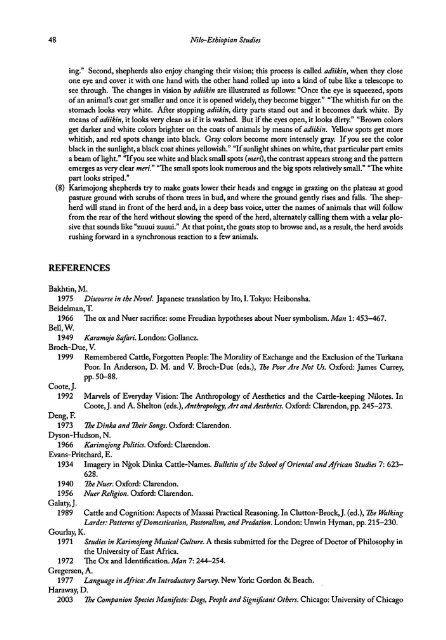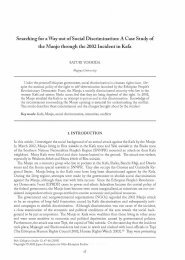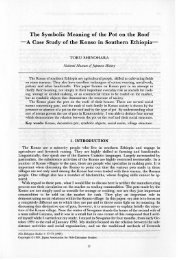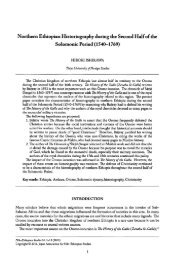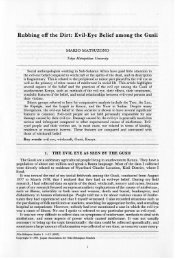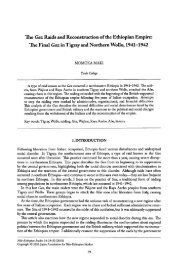Daily Life as Poetry: The Meaning of the Pastoral Songs of the ...
Daily Life as Poetry: The Meaning of the Pastoral Songs of the ...
Daily Life as Poetry: The Meaning of the Pastoral Songs of the ...
Create successful ePaper yourself
Turn your PDF publications into a flip-book with our unique Google optimized e-Paper software.
48 Nilo-Ethiopian Studies<br />
ing." Second, shepherds also enjoy changing <strong>the</strong>ir vision; this process is called adiikin, when <strong>the</strong>y close<br />
one eye and cover it with one hand with <strong>the</strong> o<strong>the</strong>r hand rolled up into a kind <strong>of</strong> tube like a telescope to<br />
see through. <strong>The</strong> changes in vision by adiikin are illustrated <strong>as</strong> follows: "Once <strong>the</strong> eye is squeezed, spots<br />
<strong>of</strong> an animal's coat get smaller and once it is opened widely, <strong>the</strong>y become bigger." "<strong>The</strong> whitish fur on <strong>the</strong><br />
stomach looks very white. Mter stopping adiikin, dirty parts stand out and it becomes dark white. By<br />
means <strong>of</strong> adiikin, it looks very clean <strong>as</strong> if it is w<strong>as</strong>hed. But if <strong>the</strong> eyes open, it looks dirty." "Brown colors<br />
get darker and white colors brighter on <strong>the</strong> coats <strong>of</strong> animals by means <strong>of</strong> adiikin. Yellow spots get more<br />
whitish, and red spots change into black. Gray colors become more intensely gray. If you see <strong>the</strong> color<br />
black in <strong>the</strong> sunlight, a black coat shines yellowish." "If sunlight shines on white, that particular part emits<br />
a beam <strong>of</strong> light." "If you see white and black small spots (meri), <strong>the</strong> contr<strong>as</strong>t appears strong and <strong>the</strong> pattern<br />
emerges <strong>as</strong> very clear meri." "<strong>The</strong> small spots look numerous and <strong>the</strong> big spots relatively small." "<strong>The</strong> white<br />
part looks striped."<br />
(8) Karimojong shepherds try to make goats lower <strong>the</strong>ir heads and engage in grazing on <strong>the</strong> plateau at good<br />
p<strong>as</strong>ture ground with scrubs <strong>of</strong> thorn trees in bud, and where <strong>the</strong> ground gently rises and falls. <strong>The</strong> shepherd<br />
will stand in front <strong>of</strong> <strong>the</strong> herd and, in a deep b<strong>as</strong>s voice, utter <strong>the</strong> names <strong>of</strong> animals that will follow<br />
from <strong>the</strong> rear <strong>of</strong> <strong>the</strong> herd without slowing <strong>the</strong> speed <strong>of</strong> <strong>the</strong> herd, alternately calling <strong>the</strong>m with a velar plosive<br />
that sounds like "zuuui zuuui." At that point, <strong>the</strong> goats stop to browse and, <strong>as</strong> a result, <strong>the</strong> herd avoids<br />
rushing forward in a synchronous reaction to a few animals.<br />
REFERENCES<br />
Bakhtin,M.<br />
1975 Discourse in <strong>the</strong> Novel. Japanese translation by Ito, I. Tokyo: Heibonsha.<br />
Beidelman, T.<br />
1966 <strong>The</strong> ox and Nuer sacrifice: some Freudian hypo<strong>the</strong>ses about Nuer symbolism. Man 1: 453-467.<br />
Bell,W.<br />
1949 Karamojo Safari. London: Gollancz.<br />
Broch-Due, V.<br />
1999 Remembered Cattle, Forgotten People: <strong>The</strong> Morality <strong>of</strong> Exchange and <strong>the</strong> Exclusion <strong>of</strong> <strong>the</strong> Turkana<br />
Poor. In Anderson, D. M. and V. Broch-Due (eds.), <strong>The</strong> Poor Are Not Us. Oxford: James Currey,<br />
pp.50-88.<br />
Coote,].<br />
1992<br />
Marvels <strong>of</strong> Everyday Vision: <strong>The</strong> Anthropology <strong>of</strong> Aes<strong>the</strong>tics and <strong>the</strong> Cattle-keeping Nilotes. In<br />
Coote,]. and A. Shelton (eds.),Anthropology,ArtandAes<strong>the</strong>tics. Oxford: Clarendon, pp. 245-273.<br />
Deng,F.<br />
1973 <strong>The</strong> Dinka and <strong>The</strong>ir <strong>Songs</strong>. Oxford: Clarendon.<br />
Dyson-Hudson, N.<br />
1966 Karimojong Politics. Oxford: Clarendon.<br />
Evans-Pritchard, E.<br />
1934 Imagery in Ngok Dinka Cattle-Names. Bulletin <strong>of</strong> <strong>the</strong> School <strong>of</strong>Oriental and African Studies 7: 623-<br />
628.<br />
1940<br />
1956<br />
Galaty,J.<br />
1989<br />
<strong>The</strong> Nuer. Oxford: Clarendon.<br />
Nuer Religion. Oxford: Clarendon.<br />
Cattle and Cognition: Aspects <strong>of</strong>Ma<strong>as</strong>ai Practical Re<strong>as</strong>oning. In Clutton-Brock,J. (ed.), <strong>The</strong> Walking<br />
Larder: Patterns <strong>of</strong> Domestication, P<strong>as</strong>toralism, and Predation. London: Unwin Hyman, pp. 215-230.<br />
Gourlay, K.<br />
1971 Studies in Karimojong Musical Culture. A <strong>the</strong>sis submitted for <strong>the</strong> Degree <strong>of</strong> Doctor <strong>of</strong> Philosophy in<br />
<strong>the</strong> University <strong>of</strong> E<strong>as</strong>t Mrica.<br />
1972 <strong>The</strong> Ox and Identification. Man 7: 244-254.<br />
Gregersen, A.<br />
1977 Language in Africa: An Introductory Survey. New York: Gordon & Beach.<br />
Haraway, D.<br />
2003 <strong>The</strong> Companion Species Manifesto: Dogs, People and Significant O<strong>the</strong>rs. Chicago: University <strong>of</strong> Chicago


